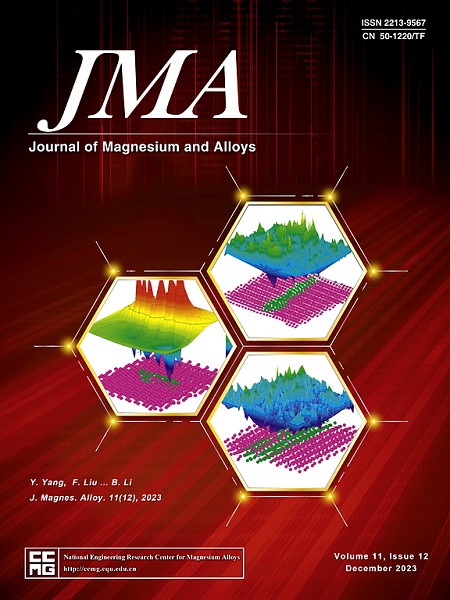AZ31B镁合金丝基搅拌摩擦添加剂制备:析出行为及力学性能
IF 15.8
1区 材料科学
Q1 METALLURGY & METALLURGICAL ENGINEERING
引用次数: 0
摘要
在添加剂制造的镁合金中,同时实现无缺陷成形和高机械性能仍然具有挑战性,其瓶颈是熔化-凝固过程中的可燃性、孔隙率和氧化风险。在这里,基于丝的搅拌摩擦增材制造(W-FSAM),通过连续喂丝,剧烈的塑性变形传输和固态沉积引发,以获得良好的Mg组件。通过剧烈的塑性变形,获得了极细的晶粒,平均晶粒尺寸为3.79µm。Al8Mn5析出相经历了细化和再分配,而Mg17Al12析出相经历了固溶和析出行为。当Mg17Al12在Al8Mn5上析出时,晶格失配率为4.92%。销状结构的强流动诱导效应削弱了W-FSAM刀具强锻造作用形成的沿构筑方向的基底织构。交替的织构特征协调了滑移和孪生的塑性变形,使其具有优异的延展性。此外,原位电子背散射衍射结果显示,在细晶结构中,晶粒旋转导致晶界滑动。这些独特的微观组织特征和析出行为增强了材料的整体力学性能,在构建方向上的极限抗拉强度为257.3±3.5 MPa,伸长率为12.4±0.3%,在行进方向上的极限抗拉强度为250.7±2.0 MPa,伸长率为12.2±0.5%。本文章由计算机程序翻译,如有差异,请以英文原文为准。

Wire-based friction stir additive manufacturing of AZ31B magnesium alloy: Precipitate behavior and mechanical properties
Simultaneous achievement of defect-free formation and high mechanical performance in additive manufactured Mg alloys remains challenging, bottlenecked by flammability, porosities, and oxidation risks within the melting-solidifying process. Here, wire-based friction stir additive manufacturing (W-FSAM), sparked by continuous wire feeding, severe plastic deformation transport, and solid-state deposition, was exploited to achieve sound Mg components. Greatly refined grains were obtained by severe plastic deformation, with an average grain size of 3.79 µm. Al8Mn5 precipitates underwent refinement and redistribution, while Mg17Al12 precipitates experienced solid solution and precipitation behaviors. Lattice mismatch was 4.92 % when Mg17Al12 precipitated on Al8Mn5. The strong flow-induced effect of the pin structure weakened the basal texture along the building direction, which was formed by the intense forging effect of W-FSAM tools. Alternating texture features coordinated the plastic deformation of slip and twinning, enabling superior ductility. Additionally, in-situ electron backscattered diffraction results revealed grain boundary sliding accommodated by grain rotation within the fine-grained structure. These unique microstructural features and precipitate behavior enhanced the overall mechanical properties, with an ultimate tensile strength of 257.3 ± 3.5 MPa and an elongation of 12.4 ± 0.3 % in building direction, and an ultimate tensile strength of 250.7 ± 2.0 MPa and an elongation of 12.2 ± 0.5 % in the traveling direction.
求助全文
通过发布文献求助,成功后即可免费获取论文全文。
去求助
来源期刊

Journal of Magnesium and Alloys
Engineering-Mechanics of Materials
CiteScore
20.20
自引率
14.80%
发文量
52
审稿时长
59 days
期刊介绍:
The Journal of Magnesium and Alloys serves as a global platform for both theoretical and experimental studies in magnesium science and engineering. It welcomes submissions investigating various scientific and engineering factors impacting the metallurgy, processing, microstructure, properties, and applications of magnesium and alloys. The journal covers all aspects of magnesium and alloy research, including raw materials, alloy casting, extrusion and deformation, corrosion and surface treatment, joining and machining, simulation and modeling, microstructure evolution and mechanical properties, new alloy development, magnesium-based composites, bio-materials and energy materials, applications, and recycling.
 求助内容:
求助内容: 应助结果提醒方式:
应助结果提醒方式:


